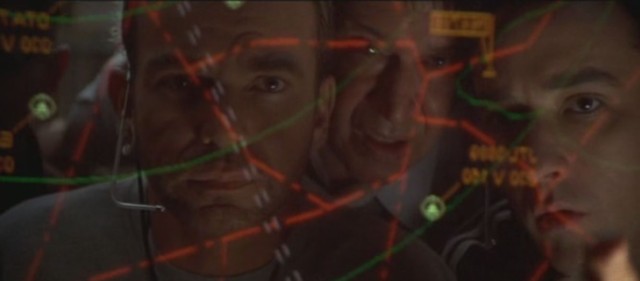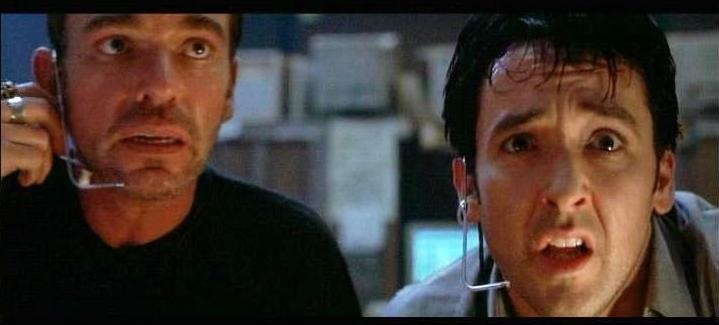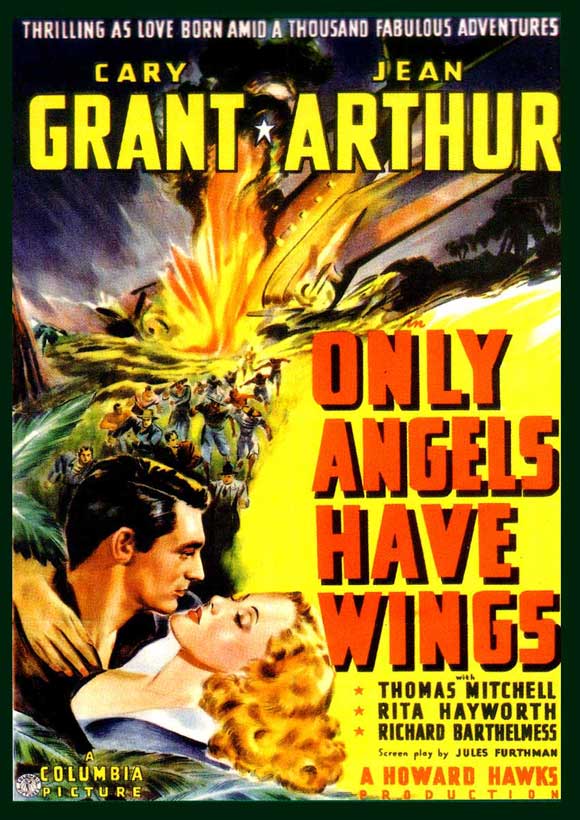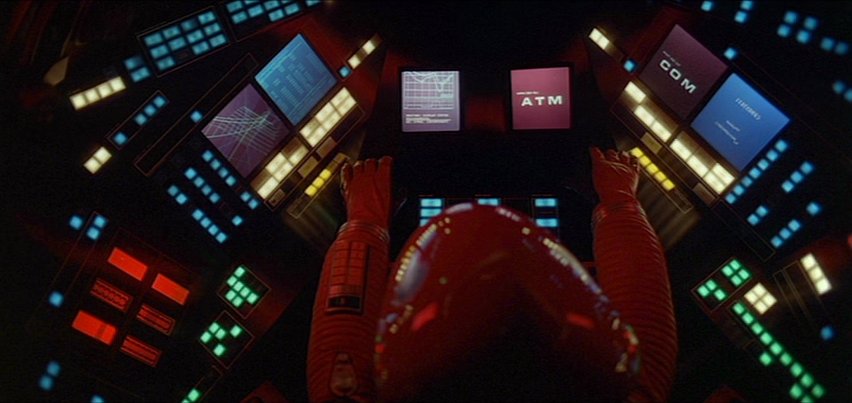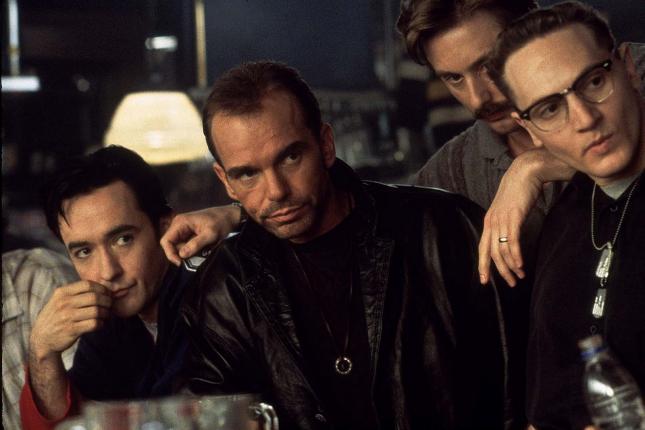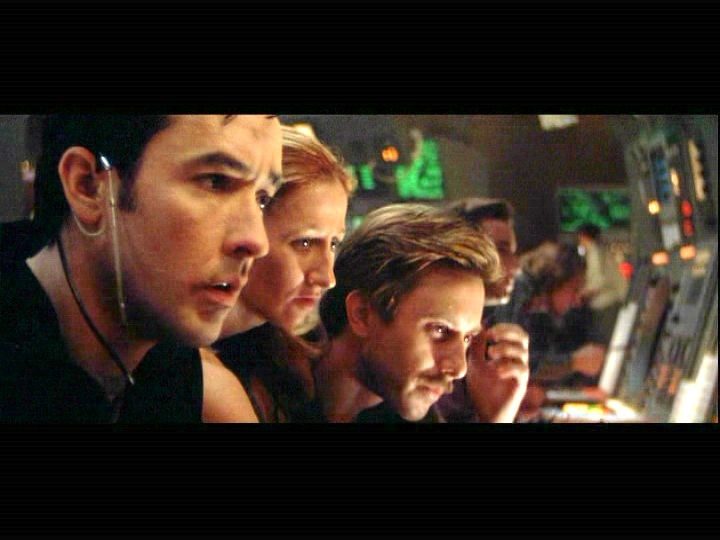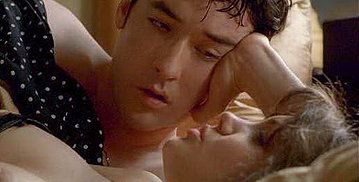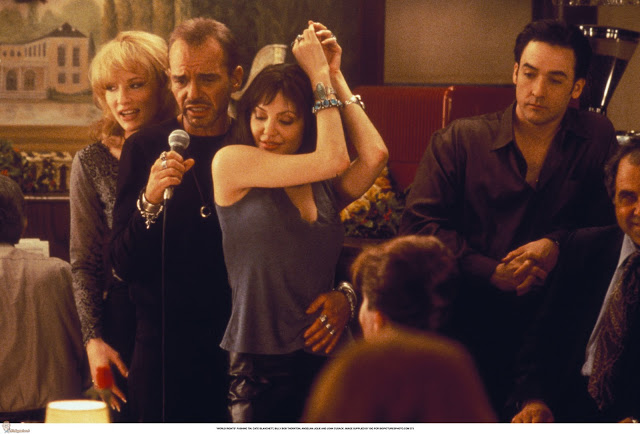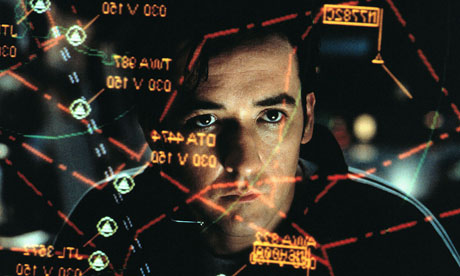From the Chicago Reader (April 30, 1999). — J.R.
Rating ** Worth seeing
Directed by Mike Newell
Written by Glen Charles and Les Charles
With John Cusack, Billy Bob Thornton, Cate Blanchett, Angelina Jolie, Jake Weber, Kurt Fuller, Vicki Lewis, Matt
Ross, Jerry Grayson, and Michael Willis.
The following notice recently appeared on the Internet Movie Database:
“In an unprecedented action, MGM said…that it is recalling all video copies of The Basketball Diaries (1995), in which Leonardo DiCaprio in a dream sequence is depicted shooting a teacher and students while wearing a long, black trenchcoat. The decision was prompted by the shootings in Colorado and references to the movie in numerous news reports. The movie was recently acquired by MGM as part of the PolyGram film library that it bought from Seagram in January. ‘We are going to attempt to get as many of these videos off the shelf as possible,’ a studio spokesman told today’s [April 22] Wall Street Journal. ‘We think it’s the responsible thing to do under the circumstances.’ He said retailers and distributors would be offered full refunds. News reports also observed that the current hit movie The Matrix also features numerous scenes of gun violence in which the hero, played by Keanu Reeves, also wears a black trenchcoat. The two suspects in the Colorado incident were members of a group called The Trenchcoat Mafia.”
It’s impossible to imagine a gun distributor saying, “We’re going to attempt to get as many of these guns off the shelf as possible. We think it’s the responsible thing to do under the circumstances.” After all, this is America, where the freedom of teenage boys to buy guns and the freedom of gun manufacturers to turn a profit are precious to our way of life. And even if we decided we wanted guns taken off shelves, or even if, foolishly, we wanted to remove The Matrix from theaters, neither would happen — because the profit margin in both cases is too large (the profits from video rentals of an old movie would be peanuts by comparison). So we’ll have to reconcile ourselves to a steady diet of pointless speculation about just what it is about trenchcoats and Littleton and bad movies that led to a bloody massacre. But worrying isn’t likely to get us anywhere.
Worrying about air-traffic controllers probably won’t get us very far either. Darcy Frey wrote in a March 24, 1996, story in the New York Times Magazine, the credited source for Pushing Tin, a new comedy about air-traffic controllers: “Almost 15 years have passed since the infamous [1981] Patco strike, which ended with President Reagan firing 11,400 of the nation’s 17,000 controllers, but the F.A.A.’s system for moving airplanes safely across the skies has never been closer to chaos. Many of the nation’s airport control towers and radar rooms still have fewer fully trained controllers than before the strike, yet the number of flights they must guide through the teeming skies has soared in some facilities by 200 percent.”
These are the key sentences in Frey’s long article, but you don’t get a scrap of this information in Pushing Tin — which is simply about how weird and crazy and harassed and sometimes fallible air-traffic controllers are, not about why they’re that way. Neither Reagan nor Patco is even mentioned, and after an exciting opening about the everyday tensions at the workplace, the movie detours into the fine points of a protracted grudge match between two controllers, one of them very loosely based on a character in Frey’s article (John Cusack as Nick Falzone), the other a total invention (Billy Bob Thornton as Russell Bell).
Cusack and Thornton are resourceful actors and fun to watch, and the actors playing their spouses, Cate Blanchett and Angelina Jolie, aren’t bad either. The players who round out the working crew are uniformly well realized, and director Mike Newell does a good job of getting them to play together. What prevents this movie from even scratching the surface of its subject is an abysmal script by two sitcom writers, brothers Glen and Les Charles, and the even worse elevator music that keeps it chugging along. This script represents a massive denial of the information contained in those two sentences of Frey’s — which is perhaps as central to the hazards of flying across America as the availability of guns is to the Littleton massacre. When Nick nearly causes two plane disasters within the space of an hour, it has nothing to do with Reagan or unions or job training or professional responsibility; it’s simply because he and Russell have been fucking each other’s wives.
A lot of reviewers have been saying that Pushing Tin begins with a lot of promise before becoming routine and forgettable, but what’s being promised is a matter of some dispute. One colleague told me he thought the movie was really going to dig into workplace detail and atmosphere the way Raoul Walsh’s They Drive by Night did. I was hoping for either a variation of Howard Hawks’s Only Angels Have Wings or a terse outline reminiscent of the lucid expositional style of Stanley Kubrick’s 2001: A Space Odyssey, of how the controllers’ spiels match up with actual air traffic. These three possibilities are somewhat at odds with one another: the interpersonal relationships of Walsh’s truckers on the Warners back lot are far from the closeted group dynamics of Hawks’s aviators within a metaphysical void conjured out of hokey sets at Columbia, while Kubrick’s film focuses on the relationship between humans and their artifacts. The film could have profitably gone in any of these directions, but after the energetic opening it obstinately settles into the primitive star politics of TV.
The biggest culprit here is the sitcom shtick, the sort of short-term foreground effects that would automatically negate the rangier visions of a Walsh, a Hawks, or a Kubrick. Early on Falzone and three of his coworkers take a break and drive to a diner for breakfast, all of them sporting sunglasses like Tarantino geeks; the rapid telegraphing of their food orders by Falzone — who relieves the waitress of her duties by delivering them directly to the short-order cook — is a clear effort to show how the frenetic speech patterns at work are carried over into the outside world. This is one of the few scenes in the movie that can be traced back to Frey’s article, where we clearly see the translation of “going down the pipes” — controller lingo for losing one’s sense of where planes are and where they’re going — into everyday life: “At Dunkin’ Donuts, Zack’s booming voice and machine-gun laugh turn the heads of several patrons, as does his order for 12 coffees, each with different milk and sugar requirements. ‘If I don’t come back with 12 coffees, the guys look down at me,’ Zack explains. As the young woman behind the counter fills the cups, Zack stands impatiently, shifting from one foot to the other and watching as she loses track of which coffees get which supplements. A panicked expression comes into the young clerk’s eyes. ‘Look!’ Zack whispers gleefully. ‘She’s losing the picture! She’s going down the pipes!'”
Unfortunately, the movie’s version of this scene translates a dozen coffees into four breakfasts that are ordered by Falzone in an impossibly baroque lingo at least three times faster than any cook could possibly take in — a splashy actor’s turn that immediately catapults the movie from the real world into Sitcomland, making us more aware of Cusack and less aware of Falzone. And as good as Cusack’s busy facial work is throughout the picture — all the more impressive given that he still looks like he’s 12 — the script keeps offering him cute stunts of this kind that interrupt the continuity of a genuine character for the sake of irrelevant cadenzas. Thornton’s Bell — conceived as a brooding, minimalist Zen master in contrast to Cusack’s spastic Woody Woodpecker, part Indian and part Mr. Natural — is short-changed by the same sort of script contrivances, in which payoffs are everything, buildups and everyday behavior close to nothing. (It doesn’t help that Falzone’s competitive and paranoid consciousness is the central fact in the movie, restricting Bell’s function to being either a threat to Falzone’s ego or a guru, without any independent status of his own.)
The spouses of this duo fare even worse. Both are given crying jags Betty Boop would balk at, and Jolie is viewed mainly through her cleavage and her bottles of vodka. Blanchett is periodically given moronic one-liners — the worst at her father’s graveside and on the airplane home afterward — not because the character is supposed to be stupid, but because the brothers Charles are trying to paper over the yawning gaps in their story.
Falzone is the seasoned veteran at the New York Tracon (Terminal Radar Approach Control), Bell the mysterious newcomer whose previous jobs were in the southwest, and the two characters square off like gunslingers in a protracted western showdown; the script is so tritely contrived that they even have a couple of rude exchanges — inaugurated by Bell’s motorcycle nearly hitting Falzone’s car — before they’re allowed to meet. Before long, Falzone is chatting up Bell’s 19-year-old wife and drinking his way into her bed; Bell reciprocates by seducing Falzone’s wife while helping her learn French.
None of this has much to do with air-traffic controlling, which is brought back into the story only when a couple of artificial climaxes are needed. The only thing that keeps the proceedings bearable is the cast gamely rolling with all the shameless sitcom punches the script keeps throwing at them. During the sporadic Tracon sessions, the possibility of coordinating the controllers’ patter with actual flight maneuvers — the Kubrickian endeavor I was hoping for — is never explored. Newell lazily cuts to a plane in the sky every once in a while but rarely bothers to connect a radar-screen crisis with anything resembling an airborne event, so the suspense of these sequences remains blandly underdeveloped.
Pushing Tin goes for the short-term kickers that appear before commercial breaks, unable to build or elaborate on anything Walsh or Hawks or Kubrick did. The versions of reality offered by those filmmakers imply sustained recognitions of one kind or another that ultimately add up to social observations, but this movie hurries past what makes air-traffic controlling an edgy business in order to keep us from thinking about what might change that business. In this respect it isn’t much different from The Matrix or even a more attractive venture like eXistenZ, though it incidentally clarifies what makes these virtual-reality movies beside the point. Since we’re already living in virtual reality — because our culture is so steeped in the fantasy evasions of TV, movies, the media in general — a true virtual-reality movie would have to offer us some version of reality if it wanted to rouse us at all. As Walsh, Hawks, and Kubrick have amply shown, that doesn’t preclude rousing entertainment.

